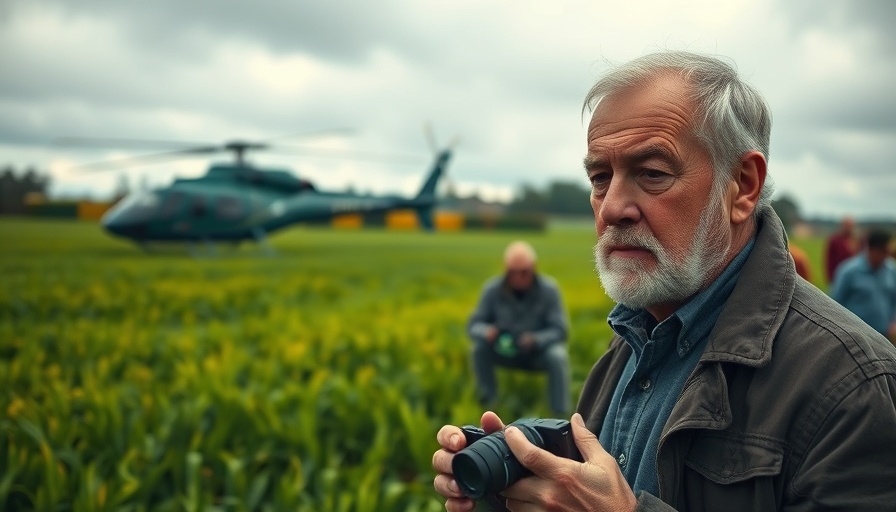
Trump's Tariff Proposal: A Threat to the Film Industry?
In a bold move that echoes his previous tariff initiatives, former President Donald Trump has announced a proposal for a staggering 100% tariff on foreign-produced films coming into the United States. This declaration, made via his Truth Social platform, reflects his concerns about the perceived decline of the American film industry and the competitive pressures from other countries offering incentives that attract filmmakers away from U.S. studios. The implications of such a sweeping tariff could shape the future of cinema in ways that resonate through both the industry and audiences.
Understanding the Current Landscape of Filmmaking
The proposed tariffs arrive during a transformative time for the film industry. Production choices increasingly lean towards countries like Canada and the U.K., where tax incentives provide substantial savings for filmmakers. This trend shifts not only production locations but the narrative of 'American cinema,' which has traditionally thrived on local talent and global storytelling. Trump's assertion that other nations’ tax incentives represent a national security threat encapsulates his broader perspective on cultural sovereignty.
Who Would Be Most Affected by the Tariff?
While Trump's tariffs are directed primarily at foreign films, the ramifications could ripple into various sectors. Independent filmmakers and small studios, who often rely on international partnerships for financing or distribution, might find new barriers that hinder their projects. Additionally, audiences who appreciate global cinema could see fewer diverse options as studios may pull back on international collaborations. Big-budget films, like the upcoming “Mission: Impossible – The Final Reckoning,” which are shot across multiple countries, could also face operational complications due to the additional costs imposed by tariffs.
Financial Implications: Cost Versus Consumer Choice
The film industry’s economic landscape is intricately tied to consumer choice. Tariffs may lead to increased ticket prices for audiences, directly impacting their theater-going experience. With American-produced films already dominating the box office, the introduction of a 100% tariff could serve to further isolate U.S. viewers from the vast world of global cinema, all while potentially worsening the economic situation for the American entertainment sector, which relies on diverse stories.
This Initiative in Context: Previous Tariff Battles
Trump's approach to tariffs has been a defining feature of his economic policy, attempting to simultaneously bolster American industries while claiming to protect national interests. The film industry, however, is uniquely complex; history has shown that broad tariffs can lead to retaliatory measures from other nations, complicating trade relations across the board. This strategy not only impacts the box office but may also lead to diplomatic tensions.
Potential Reactions from Industry Leaders
Industry leaders and advocates are likely to respond robustly to these tariff proposals. Many filmmakers argue that the essence of storytelling comes from a mixture of global influences. A united front from artists, producers, and audiences may emerge, emphasizing the value of diverse narratives in promoting cultural understanding and innovation. History suggests that the creative arts often flourish amidst collaboration, not isolation.
Looking Forward: The Future of Film Production
As the global landscape for film production continues to evolve, filmmakers and audiences alike will have to navigate an intricate web of economic pressures and creative desires. The push for tariffs introduces a perspective that prioritizes American production but simultaneously risks stifling artistic diversity. Observing the responses to this proposal and its potential fallout will be crucial as stakeholders evaluate their next steps.
The Bottom Line: Cultural Impact Versus Economic Interest
Ultimately, Trump’s proposed tariffs could redefine the relationship between American audiences and international cinema. While the intended goal may be to protect and revitalize the American film industry, the broader implications necessitate a thorough examination of how cultural narratives shape our world. The prospect of escalating costs and restricted choices may lead many to question what risks are acceptable in the name of economic protectionism.
As stakeholders from various corners of the industry weigh their options, the importance of cross-cultural storytelling remains paramount. The impending discussion surrounding tariffs on films isn’t merely about economics; it’s about the very narratives that connect us on a human level.
 Add Row
Add Row  Add
Add 




Write A Comment